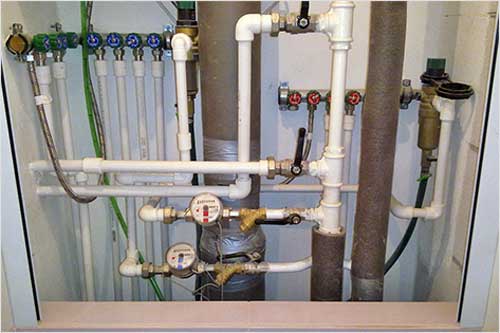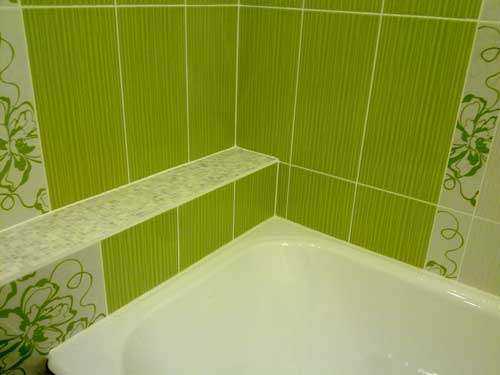How to hide pipes in the bathroom

Photo 1 - Hiding pipes in the bathroom
Sewer and water pipes, being in plain sight, can ruin even the most original design, so you need to hide them.
Rules to be observed when hiding pipes
To make the bathroom look stylish and at the same time all systems work properly and for a long time, you need to follow a few rules:
- Use pipes with a minimum number of connections, which is ensured by competent wiring and proper placement of equipment;
- Use connections that use the same material as the pipes. At the same time, the margin of safety should also be identical, or better, it would be higher.
- In order to have quick and convenient access to taps, valves and other items of equipment during revision or urgent repairs, special hatches should be provided.

Photo 2 - Plastic pipes in the bathroom
To prevent the formation of condensate on the pipes, use insulating materials. If the pipes are planned to be hidden in the wall, such insulation will also allow them to expand freely, which is especially true for pipes with hot water.

Photo 3 - Insulating material for pipes
Several ways to hide pipes
If there is a need to hide communications in the bathroom, then there are several proven methods.
Masking pipes with furniture
Hide all communications behind hinged, or built-in furniture- the simplest, fastest, and at first glance inexpensive option. For example, if the pipes are mostly vertical, then you can buy a regular pencil case of the right size. It remains only to remove the back wall and make the necessary cutouts on the panels at the top and bottom. The result is a cabinet in which you can put a lot of different things, among which there will be pipes.

Photo 4 - Masking the pipes behind the bedside table
However, this method has a significant drawback. In the place where the pipes pass, always high humidity, and it is difficult to choose furniture that can withstand such a load for a long time. Can be refinished on all surfaces waterproof material but it takes a long time and is not cheap.
This method is convenient if the house is just being built or redevelopment is being done. To hide pipes in the wall will have to grind however, if the walls are panel, then such work in the horizontal direction is prohibited. Quite often, the walls are not thick enough to perform such work.

Photo 5 - Installation of pipes in the wall
Please note that for wall mounting do not use metal pipes, as well as any connections with threaded connections. It is important to properly piping, and be sure to take into account tile thickness if cladding will be carried out. Next, you need to lay the insulation. It remains only to carry out plastering work, close the pipes and you can veneer.

Photo 6 - Pipes in the wall in the bathroom

Photo 7 - Pipes in the wall in the bathroom
How to use boxes and niches to mask pipes
The construction of the box can be considered one of the ways bathroom remodeling quite simple and convenient. A metal profile of the desired shape, or several wooden bars of the required length and section, is sheathed with sheets of drywall, which needs further finishing. It is easier and faster to build a box using plastic panels.

Photo 8 - Box for pipes in the bathroom
Niches for masking pipes are built in a similar way, but they allow you to hide not only plumbing lines, but also a washing machine, washbasin, etc.
Boxes and niches have a serious drawback - they occupy an area which is very important in a small space.
Closing pipes with a special screen
Currently, the choice of screens in stores is quite wide. It is a frame with two guides, to which plastic or drywall panels are attached.

Photo 9 - Screen under the bath photo
The cost of the screen is low, while it looks very original and attractive. In addition, it is easy to remove, which makes access to communications quite easy. The disadvantage is the same as that of boxes and niches - it takes a few centimeters of usable area.
Features of masking pipes with a plasterboard wall. Instructions for use
This option is easy to install, as well as low cost. Install plasterboard wall it is better in rooms that have not yet been inhabited, where the place of the partition is determined by the owner. This option for masking pipes is also suitable for large bathrooms.
Important!
Before starting the construction of the wall, if steel pipes are used, they must be prepared: cleaned of old paint and applied a new coating.
At the first stage, you should prepare all the necessary materials and tools.
Now you can start building the frame:

Important!
Pipe routing must be carried out at the stage of frame construction. In this case, it is necessary to take into account the thickness of the wall of drywall and tiles, if the finishing work will be carried out with its help.
Now you can proceed to the sheathing of the frame with plasterboard:


Photo 13 - Finishing the box with tiles
Installation of a drywall pipe box video
When choosing a way to hide pipes, you need to be guided by the size and style of the bathroom, as well as personal preferences and financial capabilities. You can use any of the above options, while no one limits you in creating your own method, which will be more interesting and practical.
Photo

Photo 14 - Box for pipes in the bathroom

Photo 15 - Box for pipes in the bathroom

Photo 16 - Box for pipes in the bathroom
- How to make a drain in the bath with your own hands
- Water ball valves: types, classification, device and principle of operation
- Sewerage in a private two-story house - scheme
- Piping in the bathroom: diagram and installation principle
- How to hide pipes in the bathroom with your own hands
- Repair and replacement of drain fittings of the toilet bowl
- Plastic pipes for sewerage in a private house: reliability and quality

 Live Journal
Live Journal Facebook
Facebook Twitter
Twitter